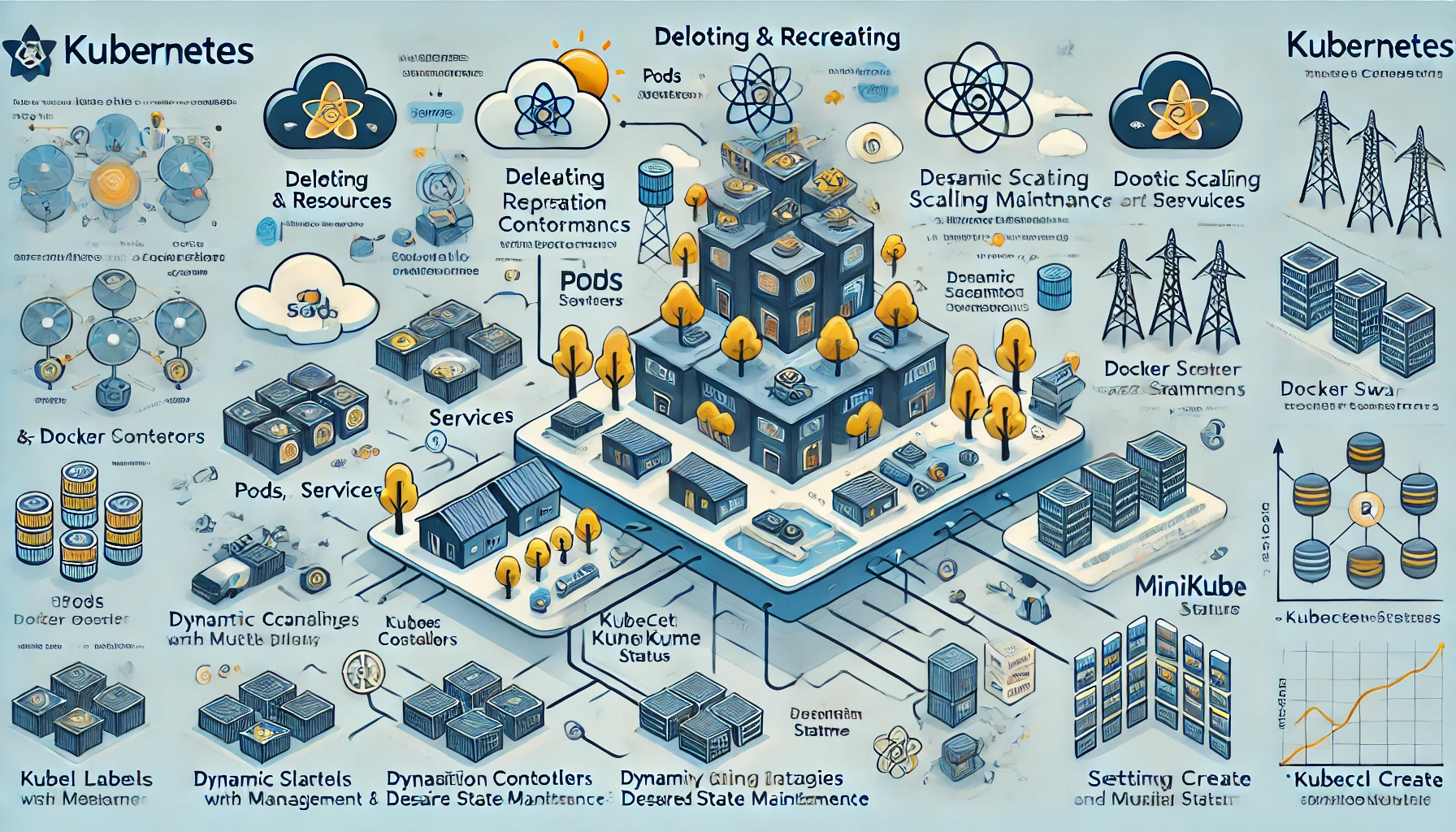Kubernetes Deep Dive: Managing Resources, Scaling, and Best Practices
 Piyush Kabra
Piyush Kabra
Deleting & Recreating Resources
Managing Kubernetes resources efficiently requires a solid understanding of deleting and recreating them. Resources such as Pods, Services, and Deployments must often be deleted and reconfigured during troubleshooting or updates.
Deleting Pods, Services, and Deployments
To delete a pod:
kubectl delete pod <pod-name>
This command removes a specific pod from the cluster. However, if a deployment manages the pod, it will be recreated automatically to maintain the desired state.
To delete a service:
kubectl delete service <service-name>
This removes the service, stopping traffic routing to the associated pods.
To delete a deployment:
kubectl delete deployment <deployment-name>
Deleting a deployment removes all pods controlled by that deployment.
Recreating Resources Using YAML Files
Instead of manually managing resources, Kubernetes allows defining resources using YAML files. YAML files provide a declarative way to manage resources, making them easier to replicate and version control.
Example YAML for a pod:
apiVersion: v1
kind: Pod
metadata:
name: example-pod
spec:
containers:
- name: nginx
image: nginx:latest
ports:
- containerPort: 80
To apply the configuration:
kubectl apply -f example-pod.yaml
This will create or update the pod definition as per the YAML file.
Kubernetes vs. Traditional Container Engines
Kubernetes provides robust orchestration, whereas traditional container engines like Docker alone handle only container lifecycle management.
Differences between Kubernetes and Docker Swarm
| Feature | Kubernetes | Docker Swarm |
| Scalability | High | Moderate |
| Load Balancing | In-built | External tools required |
| Networking | Advanced CNI plugins | Simpler networking |
| Auto-healing | Yes | No |
| Rolling Updates | Yes | Limited |
| Storage Options | Extensive | Basic |
Advantages of Kubernetes over Traditional Engines
Auto-scaling: Kubernetes can automatically scale pods up or down based on demand.
Self-healing: It automatically restarts failed pods, ensuring service reliability.
Service discovery & load balancing: Kubernetes offers built-in DNS-based service discovery and load balancing.
Automated rollouts & rollbacks: Kubernetes ensures zero-downtime updates with controlled rollouts and rollbacks.
Declarative Configuration: YAML manifests allow version control and easy replication of configurations.
Replication Controllers & Desired State Maintenance
Ensuring Desired State with Replication Controllers
Replication controllers ensure that a specified number of pod replicas are running at all times. If a pod fails or is deleted, the replication controller automatically replaces it.
Example YAML:
apiVersion: v1
kind: ReplicationController
metadata:
name: example-controller
spec:
replicas: 3
selector:
app: myapp
template:
metadata:
labels:
app: myapp
spec:
containers:
- name: myapp-container
image: nginx:latest
To apply:
kubectl apply -f replication-controller.yaml
Replica Sets and Their Importance
ReplicaSets provide an enhanced version of replication controllers, allowing selection-based pod management.
Example YAML:
apiVersion: apps/v1
kind: ReplicaSet
metadata:
name: example-replicaset
spec:
replicas: 3
selector:
matchLabels:
app: myapp
template:
metadata:
labels:
app: myapp
spec:
containers:
- name: myapp-container
image: nginx:latest
To create:
kubectl apply -f replicaset.yaml
Dynamic Scaling with Multiple Containers
Scaling Strategies with Multiple Containers
Kubernetes supports multiple scaling strategies:
Horizontal Pod Autoscaler (HPA) - Adds or removes pods based on CPU or memory usage.
Vertical Scaling - Adjusts resource limits on existing pods.
Cluster Autoscaler - Adjusts the number of nodes in the cluster.
Example of HPA:
kubectl autoscale deployment myapp --cpu-percent=50 --min=2 --max=10
Managing Resource Allocation Efficiently
Specify CPU and memory limits in pod definitions to prevent overuse.
resources:
requests:
memory: "64Mi"
cpu: "250m"
limits:
memory: "128Mi"
cpu: "500m"
Labeling & Pod Identification for Better Management
Using Labels and Annotations
Labels help in managing Kubernetes objects.
metadata:
labels:
app: myapp
Annotations store additional metadata.
metadata:
annotations:
description: "This is a sample annotation"
Label Selectors for Resource Filtering
Use label selectors to filter resources:
kubectl get pods --selector app=myapp
Using create vs. apply for Kubernetes Configuration Updates
Difference between kubectl create and kubectl apply
| Command | Use Case |
kubectl create | Creates resources, fails if they already exist |
kubectl apply | Merges updates without deletion |
Best Practices for Updating Configurations
Use
kubectl applyfor existing resources to prevent unintended deletions.Store YAML manifests in version control for easy rollbacks.
Always validate YAML before applying changes.
Minikube Cluster & Status Checking
Setting Up and Running Minikube Locally
Install Minikube and start a cluster:
minikube start
To enable the dashboard:
minikube dashboard
Checking Cluster Status and Verifying Deployments
Check cluster status:
kubectl cluster-info
Check running pods:
kubectl get pods -A
By mastering these concepts, you will be well-equipped to manage Kubernetes environments effectively with best practices!
Here are two of the most frequently asked interview questions :-
1️⃣ What is the difference between kubectl create and kubectl apply? When should you use each?
Answer:
kubectl create:Used to create a new resource in Kubernetes.
It will fail if the resource already exists.
Example:
kubectl create -f deployment.yaml
kubectl apply:Used to create or update a resource declaratively.
It merges changes into an existing resource rather than replacing it.
Example:
kubectl apply -f deployment.yaml
When to use each?
Use
kubectl createwhen defining a new resource from scratch.Use
kubectl applywhen making updates or applying changes to an existing resource.
2️⃣ How does Kubernetes ensure the high availability and self-healing of applications?
Answer:
Kubernetes ensures high availability and self-healing using the following mechanisms:
✅ Replication Controllers & ReplicaSets:
Maintain a specified number of running pod replicas.
If a pod crashes, a new one is automatically created.
✅ Auto-scaling (HPA & Cluster Autoscaler):
Horizontal Pod Autoscaler (HPA) adds or removes pods based on CPU/memory usage.
Cluster Autoscaler adjusts the number of worker nodes based on demand.
✅ Self-healing Mechanism:
If a pod fails, Kubernetes automatically replaces it.
If a node goes down, Kubernetes reschedules the pods to other nodes.
✅ Load Balancing & Service Discovery:
- Kubernetes services distribute traffic across healthy pods to ensure availability.
Would you like more detailed explanations or additional questions? 🚀
Subscribe to my newsletter
Read articles from Piyush Kabra directly inside your inbox. Subscribe to the newsletter, and don't miss out.
Written by
